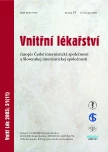The relation between prolactin values and the degree of functional disability assessed by a HAQ questionnaire in patients with rheumatoid arthritis
Authors:
Ž. Macejová 1; I. Nagyová 2; D. Trejbal 3; I. Lazúrová 1
Authors‘ workplace:
I. interná klinika Lekárskej fakulty UPJŠ a FN L. Pasteura, Košice, Slovenská republika, prednosta prof. MUDr. Ivica Lazúrová, CSc.
1; Ústav humanitných vied Prírodovedeckej fakulty UPJŠ, Košice, Slovenská republika
2; IV. interná klinika Lekárskej fakulty UPJŠ a FN L. Pasteura, Košice, Slovenská republika prednosta prof. MUDr. Ivan Tkáč, CSc.
3
Published in:
Vnitř Lék 2005; 51(11): 1260-1265
Category:
Original Contributions
Overview
Rheumatoid arthritis (RA) is a chronic inflammatory disease of joints the ethiopathogenesis of which is still uncertain. The finding that prolactin (PRL) has an influence on immunity has lead to assumptions that it may interfere with RA ethiopathogenesis. The consequences of RA consist in the destruction of joint cartilage and the adjacent bone, which causes pain and restricts the function of the affected joint. The objective of the study was to examine basally stimulated prolactin values in patients with RA in order to identify the relation between prolactin levels, inflammation markers and the patient's functional condition.
Set and methods:
The authors examined 40 patients of which 31 women aged on average 46.6 years, and 9 men, aged on average 34.7 years. A verification set of 30 volunteers was examined, aged on average 35.17 years. Prolactin levels were measured by chemiluminiscent method – immunochemical response with monoclonal antibody – using the Imunolite device. The authors evaluated the patient’s functional condition using the Stanford questionnaire for health condition assessment, applying the disability index (HAQ).
Results:
PRL values for patients with RA were higher (10.9 ng/ml) as compared with healthy population (6.9 ng/ml), without statistical significance. However, after i. v. stimulation of TRH a statistically significant increase in PRL was recorded – 20 minutes after 58.4 ng/ml stimulation and 60 minutes after 32.5 ng/ml stimulation in patients with RA, and 20 minutes after 30.9 ng/ml, and 60 minutes after 16.4 ng/ml stimulation in the verification group. A positive correlation was detected between the PRL values and the rate of functional disability assessed by the HAQ questionnaire.
Conclusion:
The study showed that hyperprolactinemia is linked with a higher rate of functional disability assessed by the HAQ questionnaire. There are two possible explanations for the positive correlation between PRL levels and the rate of functional disability. Hyperprolactinemia is often associated with depressive mood symptoms of the patient, which may also be reflected in the patient's answers filled in the functional disability questionnaire (HAQ). At the same time, this may mean that the functional disability is a stress factor for the patient and that it may be the patient proper to cause the hyperprolactinemic condition.
Key words:
rheumatoid arthritis – prolactin – functional disability – HAQ
Sources
1. Arnet FC, Edworthy SM, Bloch DA et al. The American Rheumatism Associations 1987 revised criteria for the classification of rheumatoid arthritis. Arthritis Rheum 1988; 31: 315-324.
2. Barrett JH, Brennan P, Fiddler M et al. Does rheumatoid arthritis remit during pregnancy and relapse postpartum? Results from a nationwide study in the United Kingdom performed prospectively from late pregnancy. Arthritis Rheum 1999; 42: 1219-1227.
3. Brennan P, Ollier O, Worthington J et al. Are both genetic and reproductive associations with rheumatoid arthritis linked to prolactin? Lancet 1996; 348: 106-109.
4. Dostál C, Marek J, Moszkorzová L et al. Effects of stress on serum prolactin levels in patients with systemic lupus erythematosus. Ann N Y Acad Sci 2002; 966: 247-251.
5. Greenwood MC, Doyle DV, Sieper J. Does the Stanford Health Assessment Questionaire have a potential as a monitoring tool for subjects with rheumatoid arthritis? Ann Rheum Dis 2001; 40: 344-348.
6. Hrnčíř Z. Těhotenství u žen s revmatoidní artritidou, Fysiatr RevmatologVestn 1993; 71: 10-15.
7. Jorgensen C, Mazaid H, Bologna C et al. Kinetics of prolactin release in a rheumatoid arthritis. Clin Exp Rheumatol 1995; 13: 705-709.
8. Jorgensen C, Picot MC, Bologna C et al. Oral contraception, parity, breast feeding, and severity of rheumatoid arthritis. Ann Rheumatic Dis 1996; 55: 94-98.
9. Karlson EW, Mandl LA, Hankinson SE et al. Do breast-feeding and other reproductive factors influence future risk of rheumatoid arthritis? Results from the Nurses Health Study. Arthritis Rheum 2004; 50: 3458.
10. Kreze A, Langer P, Klimeš I et al. Praktická endokrinológia. Slovak academic press, Bratislava 1993, 370.
11. Rovenský J, Bakošová J, Payer J et al. Increased demand for steroid therapy in hyperprolactinemic patients with rheumatoid arthritis. Int J Tissue React 2001; 23: 145-149.
12. Seriolo B, Ferreti V, Sulli A et al. Serum prolactin concentrations in male patients with rheumatoid arthritis. Ann N Y Acad Sci 2002; 966: 258-262.
13. Silman AJ, Kay A, Brennan P. Timing of pregnancy in relation to the onset of rheumatoid arthritis. Arthritis Rheum 1992; 35: 152-155.
14. Steinbrocker O, Traeger CH, Batterman RC. Therapeutic criteria in rheumatoid arthritis. JAMA 1949; 140: 659-662.
15. Szilasiová A, Macejová Ž, Nagyová I et al. Reliabilita a validita slovenskej verzie a modifikácia Stanfordského dotazníka hodnotiaceho zdravie pomocou indexu disability (HAQ) u pacientov s reumatoidnou artritídou. Vnitř Lék 2002; 47(1): 8-16.
16. Taiym S, Haghigham N, Al-Hashimi I. A comparison of the hormone levels in patients with Sjogren´s syndrome and healthy controls. Oral Surg Oral Med Oral Pathol Oral Radiol Endoc 2004; 97: 579-583.
17. Toth E, Horvath C. The role of adrenal and gonadal hormones in the pathogenesis of autoimmune polyarthritis. Orv Hetil 2002; 19: 1121-1128.
Labels
Diabetology Endocrinology Internal medicineArticle was published in
Internal Medicine

2005 Issue 11
Most read in this issue
- Regression equations for QT and QTc intervals of the electrocardiogram
- A rare complication after aortocoronary bypass: acute cholestatic hepatitis and agranulocytosis induced by ticlopidin and simvastatin in patients allergic to salicilates
- Type 1A diabetes mellitus and autoimmunity
- New possibilities in the treatment of chronic thromboembolic pulmonary hypertension
